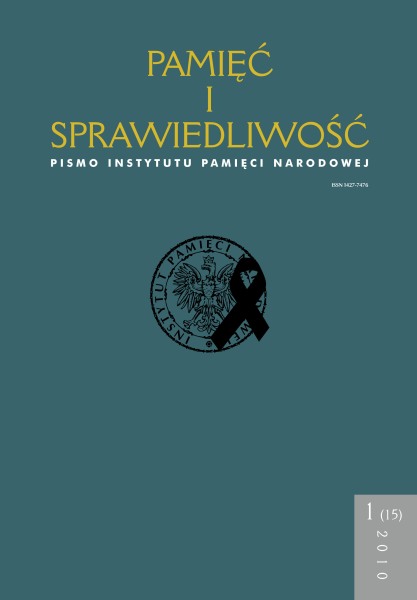Warsaw in the Face of Polish Emigration in Sweden between 1945–1968
Remembrance and Justice, Vol. 15 No. 1 (2010), pages: 73-87
Publication date: 2010-06-30
Abstract
The author attempts to trace the methods of the Polish authorities’ dealing with the Polish immigrants in Sweden between 1945–1968, seeks an answer to the question on how the immigrant communities were treated in this country and in what direction aims and methods of interfering of the Polish authorities in immigrants’life evolved.
During the later months of World War II released prisoners from the Nazi concentration camps in Germany were transported to Sweden as a part of count Folke Bernadotte and the UNRRA (The United Nations Relief and Rehabilitation Administration) action. The total number of Polish citizens staying in Sweden in the middle of 1945 is estimated to have been around 17 000. From November 1945 the Polish Repatriation Mission (Polska Misja Repatriacyjna, PMR) became responsible for the transportation of Polish citizens from Sweden to Poland. Its members were encouraging Polish citizens to coming back to their fatherland.
Until June 1947 more than 8 000 Polish citizens had left Sweden which was just over 52 per cent of all Polish citizens residing in Sweden in June 1945. The radio appeals, brochures and personal visits in camps were the PMR’s methods of agitation
for a come back to Poland as well as making efforts to discount the influence of those who remained in contact with the Polish Government in Exile in London.
During that time, the “immigration environment” was trying to provide Poles staying in Sweden with the information about the dramatic political situation in the country and also about brutal behavior of Soviet soldiers towards Polish people, etc. That “battle for souls” yielded limited results.
Soon after repatriation campaign Polish consulate, on the pretext on giving protection to their citizens, set up a registration campaign. It was announced that the consulate would offer help only those who had been registered whereas many of Polish immigrants had not applied for a residence permit. By the end of 1947, 63 per cent of Polish citizens had been registered.
Political transformations in Poland during 1955–1956 caused a change in Warsaw authorities’ position. Since that moment, common aims of all Poles like: necessity of fighting for piece, defense of the Oder-Neisse borderline, maintenance of the language and Polish tradition also in immigration environment, were being emphasized. Actions aiming to induce Poles living in Sweden to build favorable atmosphere allowing a reconstruction of Polish-Swedish trade and political cooperation were widely undertaken. The employees of the Polish consulate and embassy
were trying to create their own, rivalry organizations, separate Sunday schools. The Consular Department were editing two newspapers: „Det Nya Polen” published fortnightly and the monthly „Polska Odrodzona” („The Reborn Poland”). However, the majority of Poles living in Sweden remained apolitical because of their dispersion and working-class origins. Those, who considered themselves to be the independence immigrants were implacable.
Most read articles by the same author(s)
- Arnold Kłonczyński, History of Education in Post-War Poland – Sources, Trends and Research Perspectives , Remembrance and Justice: Vol. 42 No. 2 (2023)
 Język Polski
Język Polski
 English
English
 Deutsch
Deutsch
 Français (France)
Français (France)
 Italiano
Italiano
 Русский
Русский


 PDF (Język Polski)
PDF (Język Polski)
